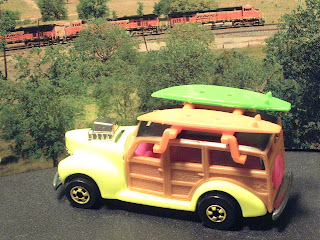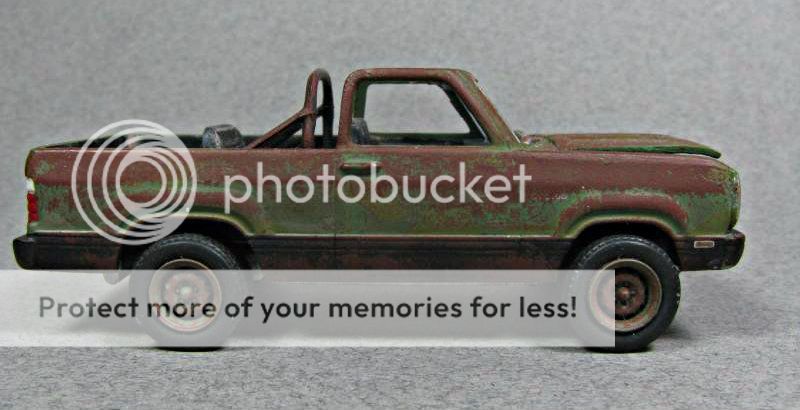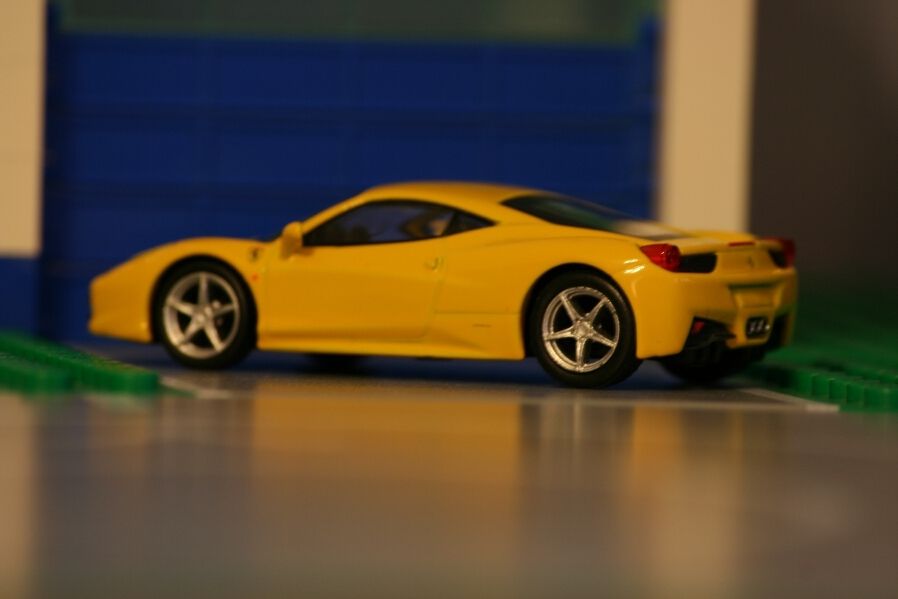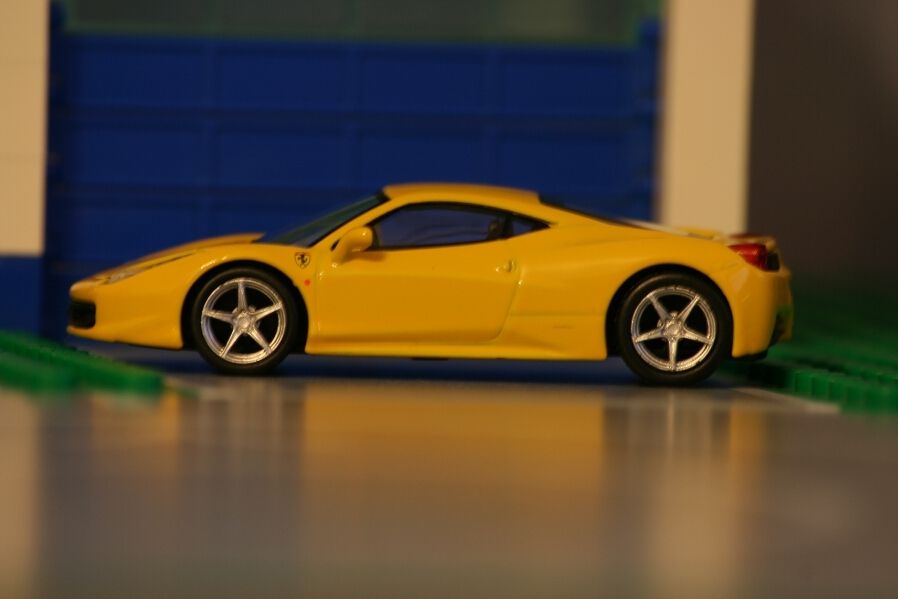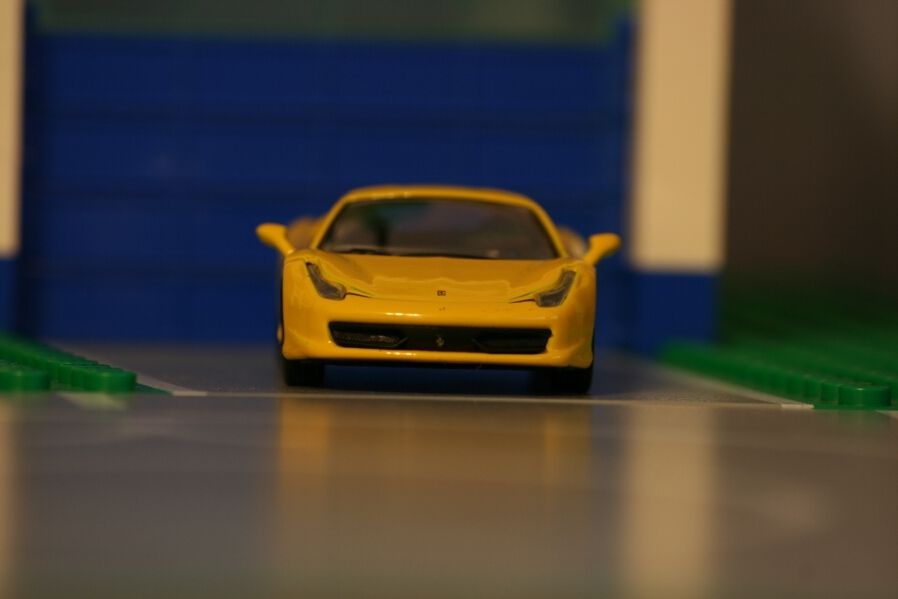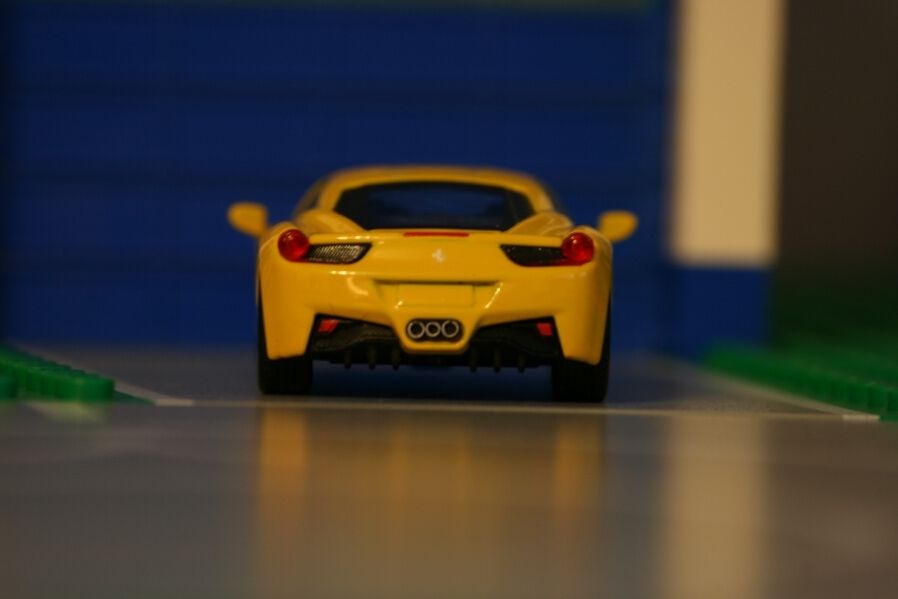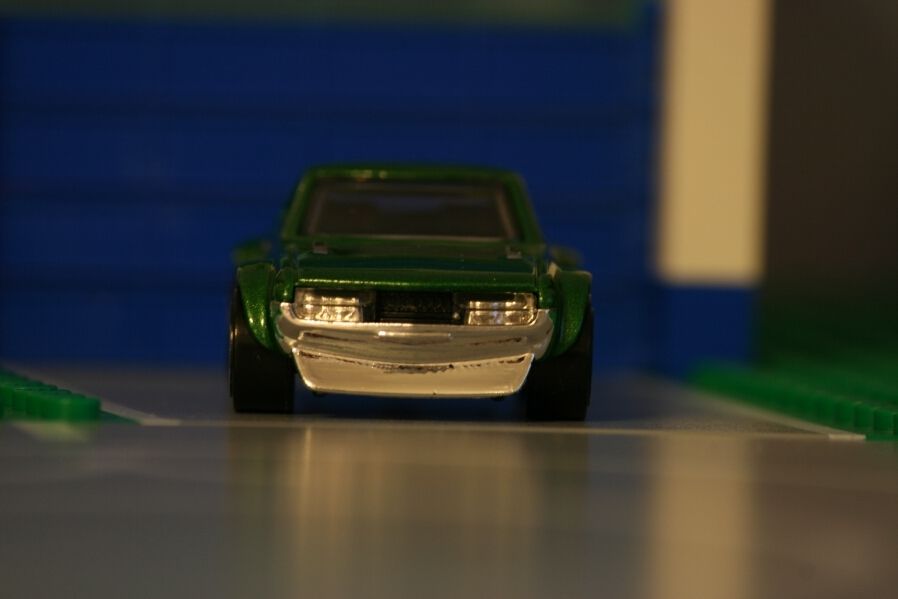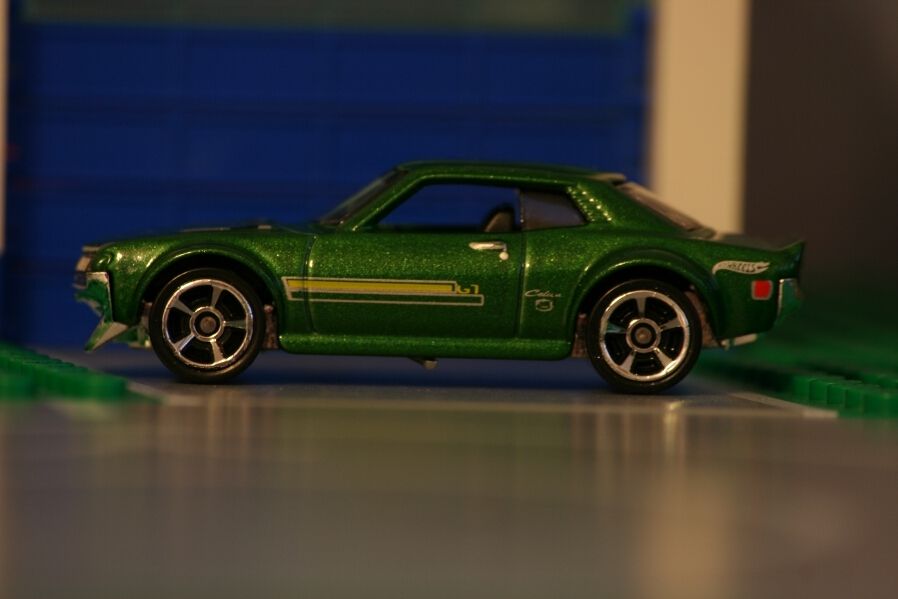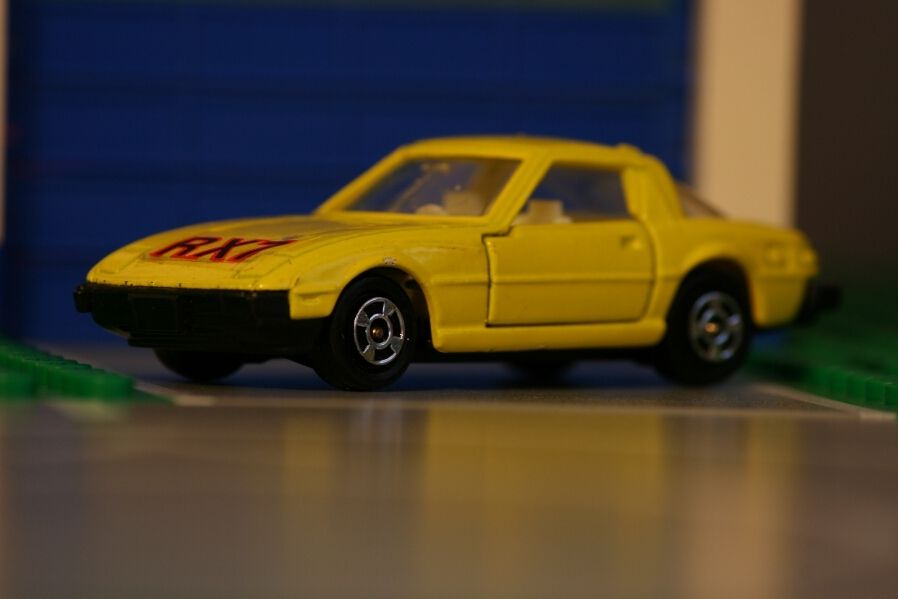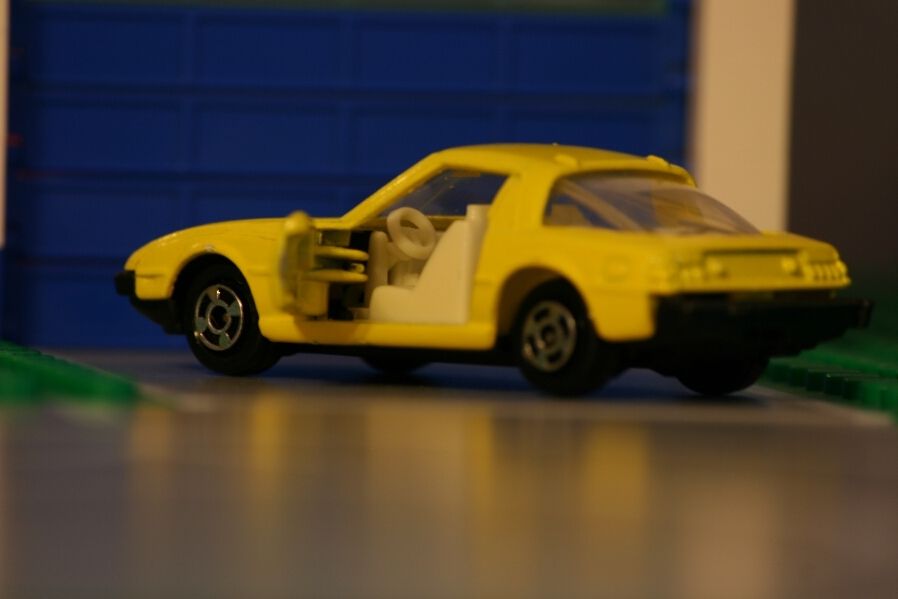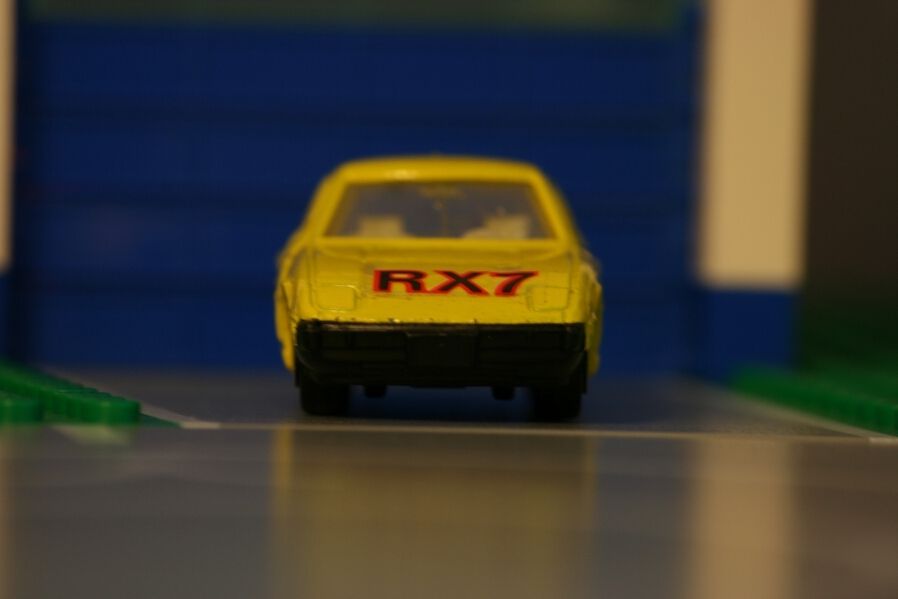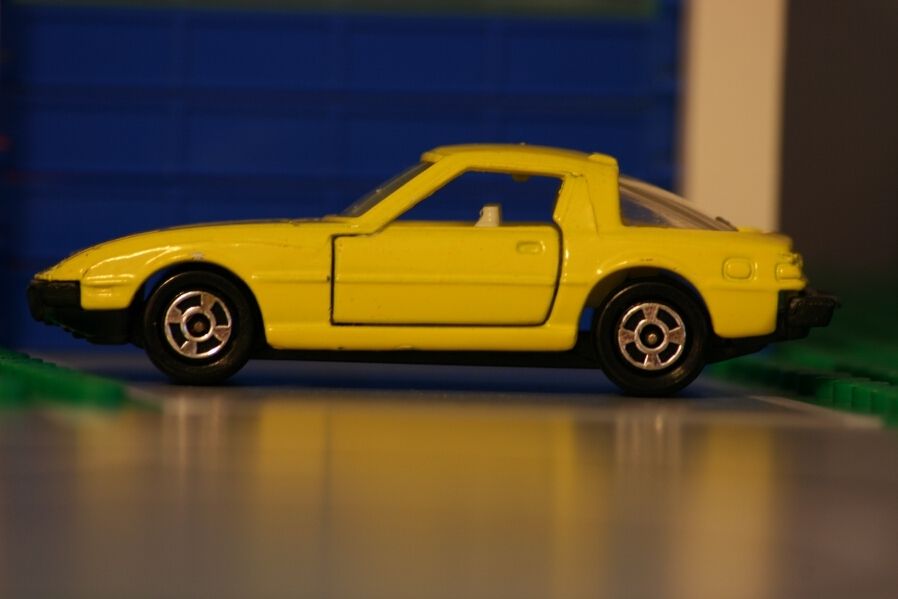
A blog focusing on 1/64 diecast from such popular brands as Hot Wheels, Matchbox, Johnny Lightning, M2 Machines, GreenLight, Tomica, Yat Ming, Majorette, MotorMax, Siku, Corgi, Guisval, Playart, Ertl, Zylmex, Racing Champions, & many more. Swifty's Garage features a daily Car Of The Day and news updates from your favorite brands!
Monday, October 29, 2012
Car Of The Day: October 29, 2012
Today's car of the day is from Firehawk73's collection, and is Kyosho's 2002 Ferrari Enzo GT Concept.
The Enzo Ferrari is a 12 cylinder mid-engine berlinetta named after the company's founder, Enzo Ferrari. It was built in 2002 using Formula One technology, such as a carbon-fibre body, F1-style electrohydraulic shift transmission, and Carbon fibre-reinforced Silicon Carbide ceramic composite disc brakes. Also used are technologies not allowed in F1 such as active aerodynamics and traction control. After a downforce of 1700lb is reached at 186 mph the rear wing is actuated by computer to maintain that downforce.
For more information and pictures of the real car please visit: Ferrari Enzo
The Enzo's V12 engine is the first of a new generation for Ferrari. It is based on the architecture of the V8 found in sister-company Maserati's Quattroporte, using the same basic architecture and 104 mm (4.1 in) bore spacing. This design will replace the former architectures seen in V12 and V8 engines used in most other contemporary Ferraris.
The Enzo was designed by Ken Okuyama, the Japanese former Pininfarina head designer, and initially announced at the 2002 Paris Motor Show with a limited production run of 349 and at US $659,330. The company sent invitations to existing customers, specifically, those who had previously bought the F40 and F50. All 349 cars were sold in this way before production began. Later, after numerous requests, Ferrari decided to build 50 more Enzos, bringing the total to 399. Before being unveiled at the Paris Motor show, the Enzo (that was used in the show) was flown from Italy to California to be filmed in Charlie's Angels: Full Throttle. It was driven on a beach by actress Demi Moore. After filming was complete, the Enzo was flown to France to be in the Motor Show. Enzos are listed as being built in 2003. In 2004 a 400th Ferrari Enzo was built and donated to the Vatican for charity, which was later sold at a Sotheby's auction for $1.1 million.
Saturday, October 27, 2012
Car Of The Day: October 27, 2012
Matchbox #60 Holden Pickup (early '70s Kingswood UTE)
This casting is from juantoo3's collection
The Holden Kingswood is a full-size car that was manufactured by General Motors-Holden's, the Australian subsidiary of General Motors (GM), from the beginning of the HK series in 1968 through to the conclusion of the WB series in 1984. It was regarded as the continuation of the previous Australian family car and was actually marketed as part of a range of models which included the basic Belmont (replacing the Standard), the Kingswood itself (replacing the Special), and the luxury-oriented Premier, all of which were manufactured in a choice of sedan and station wagon bodies. Commercial variants were offered in three types: coupé utility, panel van, and later, a heavy-duty One Tonner cab chassis. The utility (ute) version was originally marketed in both Belmont and Kingswood configurations. However, after the Belmont versions were deleted in 1974, the base model commercials were sold only with the "Holden" badge.
Outside of Australia, the Kingswood and its derivatives have been sold in New Zealand, parts of Asia, and South Africa branded as Holdens. Following the late-1960s import cessation of the Canadian-sourced Chevrolet Impala and Chevelle in South Africa, the Holden Kingswood and Premier models were badge engineered as Chevrolet Kommando and Chevrolet Constantia, respectively. In 1971, following the dropping of the Holden brand in South Africa, the Holden utilities became known as the Chevrolet El Camino. Between 1974 and 1978, the one-tonne utility was sold as the Chevrolet El Torro.
Kingswood passenger cars ceased production with the demise of the HZ series in 1980, succeeded by the smaller Commodore released two years earlier. However, the Kingswood name survived via the utility version that comprised part of the WB series range manufactured between 1980 and 1984.
The HQ series of 1971 was a completely new design, introducing larger capacity 173-cubic-inch (2.8 L) and 202-cubic-inch (3.3 L) six-cylinder engines, with the continued availability of 253-cubic-inch (4.1 L), 308-cubic-inch (5.0 L) Holden and 350-cubic-inch (5.7 L) Chev V8 engines. HQ was the most radically engineered Holden since the introduction of the original 48-215 model of 23 years prior. It featured a perimeter frame and semi-monocoque (unibody) construction, and was the first full-size Holden to have coil spring rear suspension. As a cost-saving measure, HQ was only engineered for right-hand drive, hence it was not feasible to sell the car in left-hand drive markets. Thus Holden exports declined from 41,181 in 1973 to just 7,440 in 1975. Despite this, HQ became Holden's most popular car, selling 485,650 units, a total yet to be surpassed in a Holden. It was however, sold over a longer timeframe than previous models.
More info on the real car can be found here.
This casting was occasionally marketed by Matchbox in North America as a Chevy El Camino, The removable motorcycles come in a variety of colors.
This casting is from juantoo3's collection
The Holden Kingswood is a full-size car that was manufactured by General Motors-Holden's, the Australian subsidiary of General Motors (GM), from the beginning of the HK series in 1968 through to the conclusion of the WB series in 1984. It was regarded as the continuation of the previous Australian family car and was actually marketed as part of a range of models which included the basic Belmont (replacing the Standard), the Kingswood itself (replacing the Special), and the luxury-oriented Premier, all of which were manufactured in a choice of sedan and station wagon bodies. Commercial variants were offered in three types: coupé utility, panel van, and later, a heavy-duty One Tonner cab chassis. The utility (ute) version was originally marketed in both Belmont and Kingswood configurations. However, after the Belmont versions were deleted in 1974, the base model commercials were sold only with the "Holden" badge.
Outside of Australia, the Kingswood and its derivatives have been sold in New Zealand, parts of Asia, and South Africa branded as Holdens. Following the late-1960s import cessation of the Canadian-sourced Chevrolet Impala and Chevelle in South Africa, the Holden Kingswood and Premier models were badge engineered as Chevrolet Kommando and Chevrolet Constantia, respectively. In 1971, following the dropping of the Holden brand in South Africa, the Holden utilities became known as the Chevrolet El Camino. Between 1974 and 1978, the one-tonne utility was sold as the Chevrolet El Torro.
Kingswood passenger cars ceased production with the demise of the HZ series in 1980, succeeded by the smaller Commodore released two years earlier. However, the Kingswood name survived via the utility version that comprised part of the WB series range manufactured between 1980 and 1984.
The HQ series of 1971 was a completely new design, introducing larger capacity 173-cubic-inch (2.8 L) and 202-cubic-inch (3.3 L) six-cylinder engines, with the continued availability of 253-cubic-inch (4.1 L), 308-cubic-inch (5.0 L) Holden and 350-cubic-inch (5.7 L) Chev V8 engines. HQ was the most radically engineered Holden since the introduction of the original 48-215 model of 23 years prior. It featured a perimeter frame and semi-monocoque (unibody) construction, and was the first full-size Holden to have coil spring rear suspension. As a cost-saving measure, HQ was only engineered for right-hand drive, hence it was not feasible to sell the car in left-hand drive markets. Thus Holden exports declined from 41,181 in 1973 to just 7,440 in 1975. Despite this, HQ became Holden's most popular car, selling 485,650 units, a total yet to be surpassed in a Holden. It was however, sold over a longer timeframe than previous models.
More info on the real car can be found here.
This casting was occasionally marketed by Matchbox in North America as a Chevy El Camino, The removable motorcycles come in a variety of colors.
Friday, October 26, 2012
Car Of The Day: October 26, 2012
Hot Wheels 40's Woodie (Ford)
This example is from juantoo3's collection.
A woodie is a car body style, especially a station wagon, where the rear bodywork is constructed of wood framework with infill panels of wood or painted metal.
After the demise of actual wood construction, manufacturers used simulated woodgrain sheet vinyl—sometimes augmented with three-dimensional, simulated framework—to recall wood construction. In 2008, wood construction was evoked abstractly on the Ford Flex with a series of side and rear horizontal grooves.
As a variant of body-on-frame construction, the woodie originated from the early (pre mid-1930s) practice of manufacturing the passenger compartment portion of a vehicle in hardwood. Woodies were popular in the United States and were produced as variants of sedans and convertibles as well as station wagons, from basic to luxury. They were typically manufactured as third-party conversions of regular vehicles—some by large, reputable coachbuilding firms and others by local carpenters and craftsmen for individual customers. They could be austere vehicles, with side curtains in lieu of roll-up windows (e.g., the 1932 Ford)—and sold in limited numbers (e.g., Ford sold 1654 woodie wagons). Eventually, bodies constructed entirely in steel supplanted wood construction—for reasons of strength, cost and durability.
For more information check here: Woodie
This one is a special edition set car made for the Wild Wave playset. The neon colors reflect the Cal Custom era of the late 80s, and until recently this was the only version to carry surfboards.
Thursday, October 25, 2012
Car Of The Day: October 25, 2012
The 1932 Ford Vicky by Hot Wheels is the car for today.
The Model B was a new Ford automobile produced in model year 1932. It was a much updated version of the Model A and remained largely unchanged until the 1933 model year, when the updated Model C was introduced.
Strictly speaking the Model B was a four-cylinder car with a Ford Model A engine, but it was at this time that Ford began producing a very similar car with Ford's new Flathead V8 engine. The V8 car was marketed as a Model 18, though it is commonly called the Ford V-8 today, and was virtually indistinguishable from the Model B. Until this time, Ford had always produced only one basic car at a time.
There were two versions of the ’32 – a four-cylinder and the V-8 flathead. They came in two body styles, the "5-window" (two door windows, two quarter panel windows and the rear window), and the rare "3-window" Deluxe Coupe that featured front opening doors, also known as Suicide Doors. The Deuce was called Model 18, the “1” standing for “first” and the “8” for V-8. The less popular Model B was the four-cylinder model, a refined version of the four-cylinder Model A.
The ’32 Model 18 was the first successful V-8 in a low-priced car. The 65-hp engine was used in some models costing $460. There were 14 different body styles – like the roadster, coupe, sport coupe, two-door and four-door sedans, cabriolet and phaeton. Prices ranged from $460 for the roadster and the coupe's $490 to the $650 convertible sedan. Production totals numbered only 520 for the roadster and 28,904 for the two-door coupe. Nowadays, the roadster and coupe are notable, as these body styles are more used in making the models into streetrods.
Today, the 1930s Model B is a highly collectible car that people will pay thousands of dollars to restore to exact original style. During the WWII period, when they were first getting old, the Model Bs and V8s were frequently altered into hot rods. This continued into the 1960s on a large scale. Since the 1970s, 1932 bodies and frames have been expensive, which has reduced the number of "rods" being created. Those that are made, however, are quite evolved and often very expensive. A typical auto-show hot rod is a $60,000 proposition or much more, in a few cases.
Deuce coupe is a slang term used to refer to the 1932 Ford coupe, derived from the year of manufacture. In the 1940s, the '32 Ford became an ideal hot rod. Hot rodders would strip weight off this readily available car and soup-up the engine. They came in two body styles, the more common "5-window" (two door windows, two quarter panel windows, and the rear window), and the rare "3-window" Deluxe Coupe that featured front-opening "suicide doors."
Flea markets rock, esp for finding items such as this one carded for less than a $1. The venerable Vicky debuted in the HWs line in 1969 and was later recasted in 1994. The issue shown here is from 2002.
Wednesday, October 24, 2012
SUV Of The Day: October 24, 2012
The SUV for today is Greenlight's 1977 Dodge Ramcharger (StupidSquirrel's custom).
The Dodge Ramcharger is a large sport utility vehicle built by Dodge from 1974 to 1993 (and 1999 to 2001 in Mexico), and based on a shortened-wheelbase version of the Dodge D Series/Ram pickup truck chassis. A Plymouth version, named the Trailduster and offered from 1974 to 1981, was Plymouth's only SUV.
The Ramcharger was primarily produced as a full-time four wheel drive vehicle, although a two wheel drive version was available starting in 1975. During development, it was known as the "Rhino".[1] 1974 through 1980 models have a removable hard top, although dealer-installed soft tops were available. The first year model differs from the others in that its door pillars are attached to the removable roof.
Like many vehicles, the Ramcharger was used in rallying, although its use was very limited. It did have some success, as demonstrated by achieving first place at Sno*Drift in 1975. In 1978 and 1979 the 360 CID's horsepower was bumped up to 195 horsepower (145 kW). 1978 was the last year for the 440 CID, which by then only put out 215 horsepower (160 kW).
The vehicle was usually powered by a Chrysler LA engine, the most common being the 318 cu in (5.2 L) V8. Optional was the 360 cu in (5.9 L) V8 and even big-block B series 400 cu in (6.6 L) V8 and RB 440 cu in (7.2 L) V8 were offered in the early years. Initially a normally aspirated carburetor, in 1988 the 318 gained throttle-body fuel injection with the 360 following in 1989. Power output for the TBI 318 was 230 horsepower (170 kW) and 280 lb (130 kg)-ft of torque. The TBI 360 had 240 hp (180 kW) and 283 to 295 lb·ft (400 N·m). In 1992 the multiport fuel injected Magnum 318 was the standard engine while the LA 360 with TBI was still offered. In 1993 the Magnum 360 replaced the LA engine version.
Many manual transmissions were offered throughout the years, starting with the A-230 three-speed and ending with the A-535 five-speed in 1992. The NP435 "granny gear" 4 speed was the most common in 4WD models, as well as the close ratio version, the NP445. In 1988 the clutch was converted from a mechanical linkage to a hydraulic system. Automatic transmission models had the Chrysler Loadflite TF-727A or B until, in 1991, it was replaced with the A-500/A-518 four-speed.
A full-time four-wheel drive NP-203 transfer case was standard until 1980, when it was replaced with the part-time NP-208. This was supplanted by the NP-241 in 1988.
Axles were Dana 44 front and 9¼" rear. Full time 4WD models (1973–1979) were equipped with the full time version of the Dana 44 that had no provision for locking hubs and had a front wheel bearing design with a somewhat dubious reputation. In 1980 when the part time 4WD system was introduced, the front Dana 44 was equipped with a more conventional front wheel bearing design and automatic locking hubs. Late in the 1984 model year the Dana 44 was switched to a CAD (Center Axle Disconnect) version. The CAD Dana 44 was vacuum actuated by a switch on the transfer case and powered by engine vacuum. [/quote]
[img]http://i790.photobucket.com/albums/yy190/thederbyfan83/Car-of-the-Day/IMG_9051.jpg[/img]
What's more redneck than an old beater full size SUV splashing down a muddy forest trail? :redneck: Purchased this from Ward/69Stang who had commissioned John/Stupidquirells to a series of custom small scale items. These were given the weathered and worn treatment which seems ideal to a camo colored 30+ year old Dodge.
Tuesday, October 23, 2012
Hot Rod Of The Day: October 23, 2012
The car for today is the Johnny Lightning Barris Surf Hearse.
[quote=http://theboxartden.com/Articles/Surfs_Up.html]Old cheap station wagons with their bodies of wood were the choice of surfers to transport their buddies and boards to the beach. These woodies became synonymous with surfing. Just about the ultimate of all woodies was the Surf Woody show car. One of the interesting things about it is that we can follow along from the original sketch to the building of the car to the finished product with everything being chronicled in magazines. The original Tom Daniels design appeared in February 1964 Rod & Custom. George Barris saw that and decided to build the real deal. His progress can be followed in Rod & Custom August and September 1964. The completed car and a cover shot followed in November 1964. It was then shipped to AMT in Troy, Michigan, where the Woody experienced something for which it never was intended: Snow on the ground. After all the measurements were taken for the model-making process, it started a publicity tour. One of the first places it went was Waikiki where a photo shoot resulted in the cover of Hot Rod magazine, April 1965, and also the picture for the AMT model kit. A few other woodies to be mentioned with some fantastic box art are the Aurora 1930 Ford Woody in 1/32 scale called Woodin Wagon, Monogram’s 1930 Woody Wagon, and Revell's 1931 Woody or Tudor Sedan.
For info on the life of George_Barris is a highly recommended read.
Here we have a small scale model version by JL of a 1/1 hot rod that was influenced from a 1/25 kit car. Only in America. JL only released this model in three releases with the one shown from the Classic Plastic issue dating to 2005.
Thursday, October 11, 2012
Matchbox Ambassador Report (October)
John Lamley posted links to his blog containing updates on the 60th Anniversary line from MB as well as some other 2013 releases. Check both of them out on the Lamley Blog.
http://lamleydlm.blogspot.com/
Car of the Day:October 12, 2012
Today's Car of the Day is from Jedimario's collection and is the Kyosho Ferrari 458.
Wikipedia.com
The body was designed by Pininfarina, as with all recent Ferrari models. The car’s exterior styling and features were designed for aerodynamic efficiency, producing a downforce of 140 kg (309 lb) at 124 miles per hour (200 km/h). In particular, the front grille features deformable winglets that lower at high speeds, in order to offer reduced drag.[11] The car's interior was designed using input from former Ferrari Formula 1 driver Michael Schumacher, including a new steering wheel design which incorporates many features and controls as opposed to their being on the dashboard, similar to racing car designs.
For more info on the real car,visit http://en.wikipedia.org/wiki/Ferrari_458
A non-Hot Wheels Ferrari die-cast from the last decade? Kyosho has gotten around the exclusive licensing in the same manner that Maisto did. While this car was marketed and even packaged like Kyosho's normal line, the car arrived partially disassembled and included a small screwdriver. You had to set the seats in the interior, the wheels and interior in the base, and then screw the base to the body to get the product you see here. All in all, perfectly fine, as the end result is just as professional looking as your typical high quality die-cast.
When I first saw pictures of this car, I was shocked. It looked like a spaceship. I've now gotten used to seeing it (if you can ever get used to seeing such a thing) and the effect has worn off, but it's still a radical design. Check out those exhaust tips! Very glad to have it in yellow, the other Ferrari color. It suits the car quite nicely and isn't red like most of them are.
Car of the Day:October 11, 2012
Today's Car of the Day is from Jedmimario's collection and is the Hot Wheels' 1970 Toyota Celica GT.
Wikipeida.com
Displayed at the October 1970 Tokyo Motor Show[3] and marketed in December of the same year, the Celica was a personal car that emphasized styling and driving enjoyment. Japanese models were ET, LT, ST, GT, and GTV (which was introduced in 1972, the V standing for Victory). The platform was shared with the Toyota Carina, a vehicle exclusive to Toyota Store Japanese dealerships.
For export markets, the Celica was offered in three different levels of trim; LT, ST and GT.
For more information about the real car check out http://en.wikipedia.org/wiki/Toyota_Celica
This is the latest from what is probably my favorite theme in the current Hot Wheels line: 70-80s Japanese sports cars. This one, similar to this others, is done up in period racing modifications with exaggerated fender flares and a low front spoiler. Distinctly, though, it retains factory trim and decals. A great little model with jeweled lights. The proportions aren't quite perfect and the wheels on the large size, but the casting gets the job and has loads of charm.
Wednesday, October 10, 2012
Car Of The Day: October 10, 2012
Today's Car of the Day comes from jedimario's collection and is Welly's SA Mazda RX-7.
Series 1 (1978–1980) is commonly referred to as the "SA22C" from the first alphanumerics of the vehicle identification number. This series of RX-7 had exposed steel bumpers and a high-mounted indentation-located license plate, called by Werner Buhrer of Road & Track magazine a "Baroque depression." In Japan it was introduced in March 1978, replacing the Savanna RX-3.
For more info on the real car, click here.
Ah, the first-first generation RX-7. Perhaps not a widely known fact, this car got a moderate update for 1981, so the earliest cars are a bit different and much more rare. This is the lightest RX-7, weighing in at 2,300lbs (about a hundred less than the refreshed '81). Doesn't sound like much, but when you're only making 100hp at the flywheel it makes a difference. At least that little bit of power was delivered as smoothly as possible from the 1.1L rotary motor.
Subscribe to:
Posts (Atom)



















